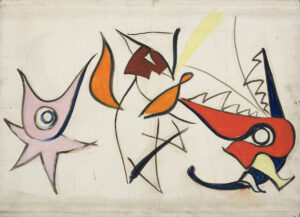Taro’s Dance
March 15(Fri.)2024-July 7(Sun.)2024

In 1952 Taro Okamoto created a tile mosaic entitled, ‘Dance.’ Unlike unique works of art, like oil paintings, it is possible to create numerous copies of mosaics and furthermore, these can be displayed outdoors. This allows art to become more accessible to society, that is what he thought. They represent the true the embodiment of Taro Okamoto’s philosophy of art.
This work, ‘Dance,’ was restored in 2011 as part of the project to celebrate the hundredth anniversary of Taro’s birth and it continues to serve as the symbol of the Osaka branch of the Takashimaya department store where it is enjoyed by countless people.
However, the question remains, why did Taro choose to use ‘dance’ as the theme for this important work? There is no way of knowing this now, but one thing we can be sure of is that Taro approved of dancing.
During the 1950s and 1960s Taro traveled throughout Japan searching for the country’s origins and is so doing, he encountered numerous folk dances that lived on in within the community. None of these were performed for show, rather they were a part of everyday life, they were themselves daily life. They could even be described as being ‘rituals of life,’ and in them, Taro discerned hints of the true nature of art.
In his private life, he loved to dance when the opportunity arose and he wrote of this as follows:
When I am dancing together with others, I remain myself while simultaneously becoming a part of the group, this experience becoming sublimated into a general sense of fulfillment, and providing a clear release of passion. For me, dance provides the most direct physical and spiritual joy.
Many of Taro’s works appear to overflow with ‘vibrancy of life,’ their motifs almost appearing to dance. They overflow with the passion and the power of life, invigorating the viewer.
This exhibition provides an opportunity to see these works together in one place and we hope that will come and enjoy Taro’s ‘clear release of passion.’
Akiomi Hirano
Director,
Taro Okamoto Memorial Museum





